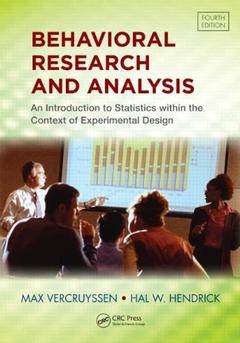Description
Behavioral Research and Analysis (4th Ed.)
An Introduction to Statistics within the Context of Experimental Design, Fourth Edition
Language: English
Subjects for Behavioral Research and Analysis:
Keywords
Phi Correlation; Bivariate Frequency Distribution; Overview of Scientific Research; Randomized Groups Design; Methods of Decribing Data; Bivariate Descriptive Statistics; Simple Experimental Designs; Key Word; Multifactor Analysis of Variance; Statistics Graphical Methods; Planning; Conducting; and Reporting Research; Univariate Descriptive Statistics; Latin Square; Variance ANOVA; ANOVA Design; Denitional Characteristics
Publication date: 11-2011
Support: Print on demand
Publication date: 02-2018
· 17.8x25.4 cm · Paperback
Description
/li>Contents
/li>Readership
/li>Biography
/li>
Now in its fourth edition, Behavioral Research and Analysis: An Introduction to Statistics within the Context of Experimental Design presents an overview of statistical methods within the context of experimental design. It covers fundamental topics such as data collection, data analysis, interpretation of results, and communication of findings.
New in the Fourth Edition:
- Extensive improvements based on suggestions from those using this book in the classroom
- Statistical procedures that have been developed and validated since the previous edition
- Each chapter in the body now contains relevant key words, chapter summaries, key word definitions, and end of chapter exercises (with answers)
- Revisions to include recent changes in the APA Style Manual
When looking for a book for their own use, the authors found none that were totally suitable. They found books that either reviewed the basics of behavioral research and experimental design but provided only cursory coverage of statistical methods or they provided coverage of statistical methods with very little coverage of the research context within which these methods are used. No single resource provided coverage of methodology, statistics, and communication skills. In a classic example of necessity being the mother of invention, the authors created their own.
This text is ideal for a single course that reviews research methods, essential statistics through multi-factor analysis of variance, and thesis (or major project) preparation without discussion of derivation of equations, probability theory, or mathematic proofs. It focuses on essential information for getting a research project completed without prerequisite math or statistics training. It has been revised many times to help students at a variety of academic levels (exceptional high school students, undergraduate honors students, masters students, doctoral students, and post-doctoral fellows) across varied academic disciplines (e.g., human factors and ergonomics, behavioral and social sciences, natural sciences, engineering, exercise and sport sciences, business and management, industrial hygiene and safety science, health and medical sciences, and more).
Illustrating how to plan, prepare, conduct, and analyze an experimental or research report, the book emphasizes explaining statistical procedures and interpreting obtained results without discussing the derivation of equations or history of the method. Destined to spend more time on your desk than on the shelf, the book will become the single resource you reach for again and again when conducting scientific research and reporting it to the scientific community.
- Illustrates how to plan, conduct, analyze, and prepare an experimental or research report
- Includes new statistical procedures that have been developed and validated since the previous edition
- Incorporates SAS in the exercises at the end of each chapter
- Takes into account the changes in the APA guidebook
- Provides new examples in exercise and sport science, public health, gerontology, and biomedical areas
Solutions manual available upon qualifying course adoption
An Overview of Scientific Research. Planning, Conducting, and Reporting Research. Methods for Describing Data. Bivariate Descriptive Statistics. Simple Experimental Designs. Simple Analysis of Variance. Multifactor Analysis of Variance. Examples of ANOVA Designs: Between Groups, Within Subjects, and Mixed Designs. Appendices.
Max Vercruyssen, PhD, is the director of Hawaii Academy, a private school for lifetime fitness, gymnastics, and human sciences, where he also serves as chair of the research department and as head coach of the school's elitelevel trampoline gymnastics teams. For the past 15 years, Dr. Vercruyssen has reduced his research activities so that he and his wife, Dr. Donna Mah, could coach their four daughters in national and international championships.
He holds a bachelor's degree in experimental psychology; master's degrees in experimental and physiological psychology, exercise and sport sciences, and public health; a PhD in neuromuscular control, and pursued postdoctoral training to earn advanced certificates in ergonomics and gerontology. Most of his advanced statistics training was under Paul A. Games (Pennsylvania State University) and as required for experimental psychology, biostatistics, and longitudinal studies of aging.At the University of Southern California (USC), Dr. Vercruyssen served as assistant professor of human factors and ergonomics, director of the Human Factors Laboratory, and codirector of the Laboratory of Attention and Motor Performance in the Andrus Gerontology Center. He also helped develop the university's ergonomics graduate degree programs and mentored the first ergonomics majors in safety science. At the University of Hawaii, he was an associate professor in psychology, gerontology, and geriatric medicine.During the 1990s, Dr. Vercruyssen was also a research associate at the University of Minnesota's Center for Transportation Research, Institute of Intelligent Transportation Systems, and a distinguished fellow of gerontechnology at the Technical University of Eindhoven, Netherlands. Dr. Vercruyssen authored or coauthored over 200 refereed publications and presented papers at international scientific and technical conferences. Nine years of his university appointments involved teaching experimenta
These books may interest you

Statistical Methods 80.63 €



